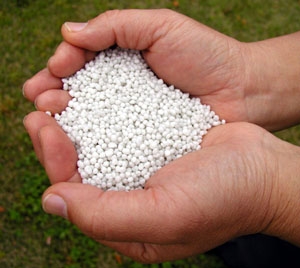Feeds for dairy cows
Nitrogen & Milk Urea Nitrogen Facts

Nitrogen (N) Facts
There is a direct relationship between protein levels in dairy cattle rations and the amount of nitrogen excreted in manure. Approximately 75-85% of consumed nitrogen (from dietary protein) is excreted when fed in excess. While fecal N excretion cannot be significantly altered, urinary N can be reduced with diets that meet cows' needs more precisely. At one time we focused on reducing nutrient losses into the environment through manure management. Now we are starting a few steps ahead by focusing on "front end" management of the herd.
Results of Nitrogen Contamination of Ground and Surface Water
Nitrogen pollution of our water supplies can have adverse effects on human health. Soil bacteria convert manure N to nitrates. In humans, nitrate in drinking water is converted to nitrite in the digestive tract. Nitrite can replace oxygen in hemoglobin, creating a compound called methemoglobin. Increased levels of methemoglobin cause oxygen levels in blood to decrease, resulting in cyanosis or oxygen starvation. Infants are very susceptible to methemoglobinemia, which is known as "Blue Baby Syndrome." Also, ingesting nitrite or nitrate from drinking water can also result in cancer.
Surface water problems also can result from excessive N levels. Nitrogen in streams causes algae to grow excessively, and in turn algae consumes the oxygen in water. Oxygen depleted water impairs survival and productivity of fish and other aquatic species.
Milk Urea Nitrogen (MUN) - A Tool to Monitor Protein Utilization
MUN provides an accurate reflection of how much N is absorbed by the cow but not used for growth or milk protein synthesis. Most of this N is provided by feed. With overfeeding of protein, excess nitrogen is excreted in milk and urine. Scientists have found a direct relationship between MUN and urinary N excretion. The MUN assay is a useful tool to tell us when the cow is wasting protein and excreting excessive N, or is fed diets deficient in N. Using MUN helps to reduce feed costs and reduce potential N losses from your farm.
How high is too high for MUN levels?

As shown in Figure 1, target MUN varies with milk yield. A group of cows averaging 80 lbs. milk/day would have a target MUN between 13 and 17 mg./dl. Most cows should fall within this range. But the expected range in MUN for a group of cows producing 50 lb. milk/day would be between 7 and 11 mg./dl.
Use the following checklist to isolate the true cause of high MUN levels on the farm:
- Milk production - How much milk are cows producing? If cows are producing less milk than expected, excess protein consumption results in elevated MUN levels.
- Diet formulation - Is the diet formulated to meet the cows' nutrient requirements? Is there an imbalance between rumen degradable protein (RDP) and rumen undegraded protein (RUP)?
- Feed analysis - Are forages analyzed routinely? Differences may exist between the actual nutrient composition of feed ingredients and the nutrient composition used in ration balancing.
- Feeding management - Are cows fed the diets which have been formulated, or is something lost in the translation from nutritionist to manager to feeder?
- Animal consumption - Are cows eating what is offered, or are they sorting and selecting part of the ration? If cows are able to sort the ration, they may consume concentrate preferentially over forage, and high MUN levels could result as well as possible herd health problems. If high protein forage (e.g., alfalfa silage) is left behind, MUN may be low.
Summary
Review your feeding program, rebalance rations if necessary, and avoid overfeeding nitrogen. MUN is a very useful tool available to identify overfeeding of N. MUN allows you to make appropriate changes in order to decrease N excretion and decrease feed costs.
Reference
Jonker, J.S., R.A. Kohn, and R.A. Erdman. 1999. Milk urea nitrogen target concentrations for lactating dairy cows fed according to National Research Council recommendations. J. Dairy Sci. 82:1261-1273.






















